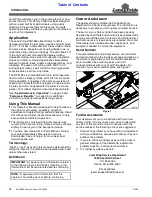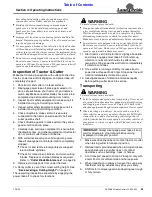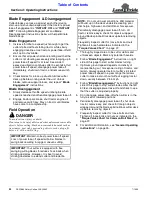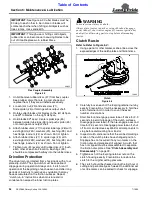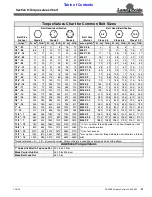
Section 4: Operating Instructions
7/13/20
RCD1884 Rotary Cutters 326-355M
23
Exceeding rated cutting capacity can damage drive
components, cutter blades, and deck components.
•
Buildup of debris around moving components and
gearboxes is a fire hazard. Keep rotating parts and
gearboxes free from debris to avoid serious injury and
•
Improper oil level can cause bearing failure and be a fire
hazard. Maintain proper gearbox oil level to avoid serious
•
Do not operate a broken or bent driveline. Such a driveline
will break apart while rotating at high speeds and can cause
serious injury or death. Always remove the implement from
use until the damaged driveline can be repaired or replaced.
•
Some tractors are equipped with two power take-off speeds.
Be certain your tractor’s power take-off shaft is set-up to
operate at 540 rpm. Do not exceed 540 rpm power take-off
speed or equipment breakage may result.
Inspection of Tractor & Cutter
Make the following inspections with cutter attached to a
tractor, power take-off disengaged, and power take-off
completely stopped:
1. Park tractor and cutter on a level surface.
2. Disengage power take-off, place gear selector in
park, set park brake, shut tractor off, and remove
switch key. Make sure cutter blades have come to a
complete stop before dismounting from tractor.
3. Inspect tractor safety equipment to make sure it is
installed and in good working condition.
4. Inspect cutter safety equipment to make sure it is
installed and in good working condition.
5. Check driveline to make certain it is securely
connected to the tractor power take-off shaft and
cutter gearbox shaft.
6. Check driveline guards to make certain they are in
good condition and in place.
7.
Carefully raise and lower implement to ensure that
the drawbar, tires, and other equipment on the tractor
do not contact cutter frame or driveline.
8. With cutter deck resting on solid supports, power
take-off disengaged, and blade rotation completely
stopped:
•
Check for and remove foreign objects wrapped
around blade spindles.
•
Check for nicked, bent, broken, and worn cutting
blades. Replace or sharpen blades as required.
Refer to
9. Remove solid supports from under the deck.
10. Verify cutter is set at the correct cutting height. See
“Deck Leveling & Cutting Height”
The remaining inspections are made by engaging the
power take-off to check for vibrations.
WARNING
!
To avoid serious injury or death:
•
Stop power take-off immediately if vibration continues after
a few revolutions during start-up and anytime thereafter.
Wait for all components to come to a complete stop before
dismounting from tractor to check for probable causes.
Make necessary repairs and adjustments before continuing.
•
Some tractors are equipped with two power take-off speeds.
Be certain your tractor’s power take-off shaft is set-up to
operate at 540 rpm. Do not exceed 540 rpm power take-off
speed or equipment breakage may result.
11. Start tractor, set throttle to idle or slightly above idle,
and slowly engage power take-off. Initial start-up
vibration is normal and should stop after a few
revolutions. Stop power take-off rotation immediately
if vibration continues.
12. Once cutter is running smoothly, increase tractor
power take-off speed to 540 rpm. Stop power take-off
rotation immediately if vibration occurs.
13. Investigate cause of vibration and make repairs
before putting cutter back into service.
Transporting
WARNING
!
To avoid serious injury or death:
•
Select a safe ground speed when transporting. Never travel
at a speed which does not allow adequate control of steering
and stopping, and never exceed 20 mph (32.2 km/h) with
attached equipment. Rough terrain requires a slower speed.
•
When traveling on roadways, travel in such a way that
other vehicles may pass you safely. Always use LED lights,
clean reflectors, and a slow moving vehicle sign that is
visible from the back to warn operators in other vehicles of
your presence. Always comply with all federal, state, and
1. Make sure driveline does not contact tractor or cutter
when raising cutter to transport position.
2. Reduce tractor ground speed when turning and leave
enough clearance so cutter does not contact
obstacles such as buildings, trees, or fences.
3. Limit transport speed to 20 mph. Transport only with
a farm tractor of sufficient size and horse power.
4. When traveling on roadways, transport in such a way
that faster moving vehicles may pass you safely.
5. Shift tractor to a lower gear when traveling over rough
or hilly terrain.
Always disengage power take-off and


